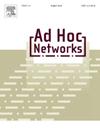Battery life optimization in LoRa networks using spreading factor reallocation
IF 4.8
3区 计算机科学
Q1 COMPUTER SCIENCE, INFORMATION SYSTEMS
引用次数: 0
Abstract
This paper proposes a dynamic strategy for the allocation of resources used by end devices in LoRa networks, which employ chirp spread spectrum modulation. The proposed battery life optimization (BLO) strategy splits end devices into different spreading factor (SF) groups. The basic idea is to reduce the collisions between end devices using the same SF. Moreover, BLO also considers the current battery level of each end device, and periodically reallocates the SF groups to optimize the battery consumption of all nodes and extend the network lifetime. The main innovation of BLO is to consider in addition to the RSSI the air time of different SFs as a weighting factor in SF allocation. We compare BLO to state-of-the-art (SoA) SF-allocation strategies, achieving 77% improvement in successful message delivery compared to LoRaWAN’s ADR scheme. Furthermore, we obtain better energy efficiency with BLO. In a scenario with one gateway and 500 devices operating over 24 h, the remaining energy with BLO is 10 and 3.6 times larger than with EXPLoRa-SF and EXPLoRa-AT SoA strategies, respectively.
基于扩展因子再分配的LoRa网络电池寿命优化
本文提出了一种采用啁啾扩频调制的LoRa网络中终端设备资源的动态分配策略。提出的电池寿命优化(BLO)策略将终端设备划分为不同的扩展因子(SF)组。其基本思想是减少使用相同SF的终端设备之间的碰撞。此外,BLO还考虑了每个终端设备当前的电池电量,并定期重新分配SF组,以优化所有节点的电池消耗,延长网络寿命。BLO的主要创新之处在于除了RSSI之外,还考虑了不同SFs的播出时间作为SF分配的权重因素。我们将BLO与最先进的(SoA) sf分配策略进行了比较,与LoRaWAN的ADR方案相比,成功的消息传递提高了77%。此外,我们获得了更好的能源效率与BLO。在一个网关和500个设备运行超过24小时的场景中,使用BLO的剩余能量分别是使用explore - sf和explore - at SoA策略的10倍和3.6倍。
本文章由计算机程序翻译,如有差异,请以英文原文为准。
求助全文
约1分钟内获得全文
求助全文
来源期刊

Ad Hoc Networks
工程技术-电信学
CiteScore
10.20
自引率
4.20%
发文量
131
审稿时长
4.8 months
期刊介绍:
The Ad Hoc Networks is an international and archival journal providing a publication vehicle for complete coverage of all topics of interest to those involved in ad hoc and sensor networking areas. The Ad Hoc Networks considers original, high quality and unpublished contributions addressing all aspects of ad hoc and sensor networks. Specific areas of interest include, but are not limited to:
Mobile and Wireless Ad Hoc Networks
Sensor Networks
Wireless Local and Personal Area Networks
Home Networks
Ad Hoc Networks of Autonomous Intelligent Systems
Novel Architectures for Ad Hoc and Sensor Networks
Self-organizing Network Architectures and Protocols
Transport Layer Protocols
Routing protocols (unicast, multicast, geocast, etc.)
Media Access Control Techniques
Error Control Schemes
Power-Aware, Low-Power and Energy-Efficient Designs
Synchronization and Scheduling Issues
Mobility Management
Mobility-Tolerant Communication Protocols
Location Tracking and Location-based Services
Resource and Information Management
Security and Fault-Tolerance Issues
Hardware and Software Platforms, Systems, and Testbeds
Experimental and Prototype Results
Quality-of-Service Issues
Cross-Layer Interactions
Scalability Issues
Performance Analysis and Simulation of Protocols.
 求助内容:
求助内容: 应助结果提醒方式:
应助结果提醒方式:


